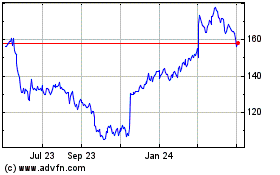Target Slashes 2017 Outlook as Holiday-Quarter Sales Fall -- 3rd Update
February 28 2017 - 2:58PM
Dow Jones News
By Khadeeja Safdar
Target Corp.'s chief vowed to invest billions to lower prices
and remodel hundreds of stores, an admission that the retailer's
focus on trendy merchandise wasn't enough to attract shoppers.
Chief Executive Brian Cornell defended his
brick-and-mortar-centric strategy Tuesday after Target reported
sales and profit declines for the holiday quarter, and gave an even
gloomier outlook. The company said its 2017 profits would fall as
much as 25% below what Wall Street had forecast.
The warning sent Target shares skidding 12% to $58.87 in Tuesday
afternoon trading. The shares have now erased nearly all the gains
since Mr. Cornell took the reins in August 2014 in the wake of a
massive customer-data breach.
Calling 2017 "a year of investment," Mr. Cornell said Target
would put $2 billion this year and $7 billion over the next three
years into improving its stores, launching exclusive brands and
developing its supply chain and digital capabilities. The company
is also investing $1 billion this year to lower prices and drive
digital sales that come at a lower margin.
Mr. Cornell said he expects Target to return to earnings growth
in 2019. This multiyear plan "is the right path for the company
now," he added. "It will be the right path for the company 10 years
from now."
The changes come more than a year after rival Wal-Mart Stores
Inc. began pouring money into revamping its stores, lowering prices
and expanding its e-commerce operations -- changes that reversed a
sales slump. Target has also been squeezed by the expansion of
Amazon.com Inc., which shares many customers and products with
Target.
Under Mr. Cornell, Target has centered much of its growth
strategy around its roughly 1,800 stores and regaining its cachet
for selling fashionable products. He pushed the addition of
specialty foods and trendy labels developed in-house, such as
children's apparel brand Cat & Jack.
Although Mr. Cornell said Target would continue to push style
and new brands, on Tuesday he took a page out of Wal-Mart's script
by saying the company needed to return to "everyday low
pricing."
Mr. Cornell said the company planned to revamp as many as 600
locations over the next three years, and open 100 smaller locations
in college towns and urban areas. There are no plans for mass
closings, he said, and the retreat of department stores was an
opportunity for Target to grab market share. "We are not
mall-based," he added.
Since he became CEO, Mr. Cornell helped Target regain its
footing after the credit-card breach. He exited the Canadian market
and sold the company's pharmacies to CVS Health Corp. But the
former PepsiCo Inc. and Sam's Club executive's turnaround efforts
began to stall last year, as fewer shoppers visited Target's stores
and spending moved online.
Analysts predict that Target will continue to lose market share
to Amazon and other online sellers if it doesn't do more to adapt
to the digital age. In a recent study, Goldman Sachs found that
Target customers are more likely to have an Amazon Prime membership
than those of Wal-Mart and other discount retailers.
Some have suggested drastic cost-cutting moves. Target needs to
consider closing stores and exiting underperforming categories such
as media, John Zolidis, an analyst at Buckingham Research Group,
wrote in a research note this week.
Brick-and-mortar chains are struggling with dwindling foot
traffic and shrinking profit margins as more U.S. consumers do
their shopping online. Several retailers, including Macy's Inc.,
Sears Holdings Corp. and J.C. Penney Co., have recently announced
plans to close hundreds of stores to combat weak sales.
"We believe structural changes have been at Target's doorstep
for years, but the company's strong connection with next-generation
consumers and moms led us to believe it could steadily move its
business more online," wrote analysts at Piper Jaffray. "That was
clearly too optimistic."
Comparable sales in Target's digital business rose 34% in the
fourth quarter but still make up only a fraction of overall
revenue. Mr. Cornell initially targeted 40% online sales growth
over five years, but the company didn't reach that goal in
2016.
During the fourth quarter, Target's sales at stores open at
least a year fell 1.5%, which was the low end of the company's
guidance. The company also predicted that comparable sales, which
include online revenue, would fall this year.
Target said it would use more of its stores to fulfill online
orders and work to cut its inventory -- something its operating
chief John Mulligan said it had too much of. "We need to get faster
and more reliable," he said.
Overall for the quarter, Target reported a profit of $817
million, or $1.45 a share, down from $1.43 billion, or $2.32 a
share, in the year-ago period. Sales fell 4.3% to $20.69
billion.
--Joshua Jamerson contributed to this article.
Write to Khadeeja Safdar at khadeeja.safdar@wsj.com
(END) Dow Jones Newswires
February 28, 2017 14:43 ET (19:43 GMT)
Copyright (c) 2017 Dow Jones & Company, Inc.
Target (NYSE:TGT)
Historical Stock Chart
From Mar 2024 to Apr 2024

Target (NYSE:TGT)
Historical Stock Chart
From Apr 2023 to Apr 2024
